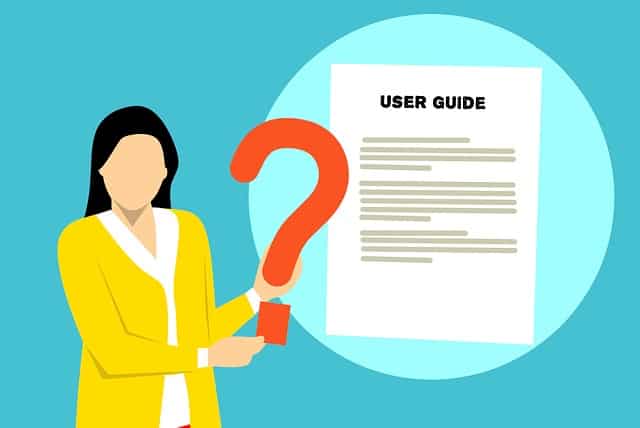Email List Building & Lead Magnets: A 12-Step Guide Using AI

Email list building is one of your first tasks as an online marketer. It is vital to your potential success as an entrepreneur. List building allows you to communicate directly with your target audience rather than hope they return to your site someday.
But many marketers fail at this task. Some try to wait until they make it big to begin building a list, which is a huge mistake because it means lost income and subscribers. Others don’t create an enticing lead magnet, so no one cares about signing up.

For those who make an effort, their copywriting skills might sabotage any chance of converting a visitor into a subscriber because their landing page lacked what was needed to convince people to exchange their contact information for the gift.
Below, you’ll find a step-by-step guide to using artificial intelligence (AI) to help you create an appealing lead magnet offer – and craft the copy to go with it to get people on your list and cater to their needs as a niche leader.
You can use any AI tool you want, but we’ll use a mixture of Google’s free BARD AI tool and ChatGPT for this lesson. There are free and paid AI tools, so you’ll need to find one that works best for your budget.
Email List Building Step 1: Use AI to Understand the Needs of Your Prospective Subscribers
Example Used: Newbie Marketers
For this report, we will assume our target audience is newbie marketers. These people are just starting their journey to become online entrepreneurs, so we need to understand their needs so that our lead magnet can cater to them.
You already know of a few pain points or goals for your audience. When you prompt your AI tool, be sure to include those. You’re hoping to get a comprehensive list to pinpoint something that will set you apart from the basic information they can find for free online.
So we’ll prompt BARD and ChatGPT with this statement:
“I need a comprehensive list of the most pressing pain points or areas of confusion for new online entrepreneurs. It can be financial, emotional, educational, or other, but they should all point to a particular demographic’s struggle or concern.”
With more detail than this, AI is going to tell you that newbie marketers are most concerned with these aspects:
- Finances
- Lack of clarity or direction
- Limited time and resources
- Inadequate knowledge or education
- Fear of failure
- Finding a niche or USP
- Building a brand
- Balancing creativity and productivity
- Managing customer relationships
- Understanding technology·
- Lack of support and network
Now when you look at this list, you can put yourself in the shoes of a new online entrepreneur, and you instantly know some of these are not what most newbies find to be a crucial pain point.

They’re likely most concerned with finances, fear of failure, not understanding something technical, or knowing what direction to head in. They might worry about managing time if they’re trying to build this business while holding another job.
But most newbies are sitting there right out of the gate, wringing their hands over finding a USP (unique selling proposition) or managing customer relationships. They probably don’t even have customers yet.
You can also prompt AI to ask it:
“Why do most people consider starting an online business?”
It will mention several things like flexibility and pursuing a passion. Still, finances come into play a few times – both with low startup costs and the ability to supplement their income and scale their business so they can achieve financial security.
So now you know your niche audience’s pain points and goals. You’ll want to pick one thing to focus on for your lead magnet. Remember, you can always create multiple lead magnets and landing pages using these ideas, but you must have a starting point.
Email List Building Step 2: Select a Pain Point or Goal and Expand on It Using AI
When you’ve been in this industry a long time, you know that financial desperation is one of the biggest concerns for most newbies. Many come into this industry broke – not having a job or being unable to make ends meet.
So we’re going to go with the financial slant. When you review your list, compare the topics and choose one you feel would be the most crucial factor to your audience. It can be a goal or a pain point.
The next thing you have to do is prompt AI to expand on your idea. If you ask it very simply, it will deliver a simple answer. So we’ll say this instead:
“What are all the financial concerns and goals a new online entrepreneur has when considering starting an online business? Be comprehensive and detailed.”
It will give you results, but before you even glance at them, prompt AI with this request:
“Please give me more of their concerns and goals but don’t repeat any you’ve already mentioned.”
You ask this because it always has more it can provide. So starting, AI would have told you (in more detail than what’s listed below) that you need to address things like:
- Startup costs
- Cash flow
- Profitability
- Pricing
- Tax considerations
- Funding
- Scaling·
- Risk Management

Then it would add things like:
- ROI
- Payment processors·
- Buying inventory and more
AI can give you a lot of information about data it has, but it lacks the human emotions you can understand. Imagine your customer – a newbie concerned with finances.
They are likely getting into this business because they’re struggling with money. While being an online entrepreneur sounds like a fantastic opportunity, they don’t have the money to spend on a substantial startup.
So you might focus on keeping startup costs low and pair it with quick monetization or high profitability. Your next step is to let AI develop a title that will appeal to prospective subscribers based on this concept.
Step 3: Have AI Create a Hyped-Up Title That Oozes Value for the Reader
We will ask AI for a list of titles because if you ask for only one title, you may have to keep asking for additional ones until you find one you like. Plus, with a list, you can mix and match the wording.
Prompt AI with something like this:
“I need a list of hyped-up titles for a report about keeping startup costs low and pair it with something like quick monetization or high profitability.”
BARD vs ChatGPT
BARD and ChatGPT have very different styles for the results. Let me show you the difference. Google’s BARD delivers plain results like: “How to Start a Profitable Online Business with No Money Down.”
That’s an OK title. Nothing wrong with it. But ChatGPT will be written more like a marketing headline, like this: “Startup Success on a Shoestring Budget: How to Keep Your Costs Low and Your Profits High!”
The first option sounds like a plain blog post. But the second one sounds like it will motivate and inspire the reader more. So we’ll go with that one. Now, when looking at your results, you’ll spot patterns – regardless of your niche.
Words and phrases like this are popular:
- Ultimate guide to
- Secrets to
- Definitive guide to
- The step-by-step guide to
- The blueprint for
- Mastery·
- How to
As you can see, this type of wording can work for any niche – weight loss, survival, anti-aging, pets, and more. If you know of a specific language you want to use, tell AI to include it in the title, and it will!
You can choose whichever will work best for your lead magnet. We will title the lead magnet: Startup Success on a Shoestring Budget and use the “How to Keep Your Costs Low and Your Profits High” portion as the tagline on the book.
Step 4: Pick the Topics for Your Lead Magnet and Use AI to Create a Logical Outline
If the list of pain points and goals included many items that could go into your lead magnet, you want to pick those topics to ensure the artificial intelligence tool has them in your outline.

Now that we have a narrower topic, we can prompt AI to expand on that issue. Instead of all the finances, we will focus on startup costs and keeping them low.
We will also prompt AI to include some information afterward about maximizing profits. Still, we have to focus on the primary slant of low-cost startups for the most part because if they can’t even get their business off the ground, the profits won’t even enter the picture.
For our particular slant, we will prompt the AI like this:
“I’m writing a book called Startup Success on a Shoestring Budget,” I want it to include information about how to keep costs low when starting an online business. You’ll be coming up with chapter topics to cover for things marketers have to spend money on (like a domain and hosting, courses, tools, autoresponders, etc.) and how they can avoid paying too much on these if they have to spend at all. Logically organize the chapters.
Now BARD didn’t listen to instructions. It has one chapter on finances, but the rest is about making your website user-friendly, marketing your business, customer service, etc.
ChatGPT, on the other hand, knocked it out of the ballpark with chapters about:
- Defining their budget and why it’s important to keep costs lost
- Website essentials and comparing prices or going the free route
- Using social media to drive free traffic to your site
- Using free (open source) tools and resources in your marketing
- Partnering up to save on costs
- Building an email list on a budget
- Keeping outsourcing costs low·
- Reinvesting to scale your business without overspending
This outcome is exactly what a newbie niche marketer needs to know! BARD went too broad and abandoned the financial aspect in most of its answers. All hope is not lost, though. If you’re using this free AI tool, redirect it!
AI is there to learn from you. Tell it this:
“I want every chapter to relate to keeping startup costs low, so please redo it.”
And it will then give you chapters like this:
- How to start an online business with no money
- How to save money on your domain and hosting
- How to create a website on a budget
- How to market your online business for free
- How to grow your online business without spending a lot of money
It still tries to veer off with additional chapters about protecting your business from fraud, security threats, etc. But as long as it provides some things you can use, it’s helpful –don’t copy, paste and use it all.
We will use ChatGPT’s outline because it’s comprehensive and addresses what newbies need to know, but it’s missing one thing that newbies tend to spend too much on – courses.
So we will add a chapter on that and prompt the AI tools to develop better chapter titles for us. We will say this:
“Below is an outline for a book called Startup Success on a Shoestring Budget. I need you to write better chapter titles and hype them up.” (Then include the chapter list.)
Edit Ruthlessly
Below is what ChatGPT came up with for us, and you’ll notice they’re all pretty long, so you can chop some of the wording off if you prefer:
- The Power of a Penny Pincher: Defining a Budget and Unleashing Your Entrepreneurial Spirit. (We will cut the first part off and start with the word Defining).
- Web Presence for the Win: Navigating Website Essentials and Comparing Costs vs. Free Options. (We will cut the first part off and start with the word Navigating).
- Hack Your Way to an MBA: Giving Yourself an Education on a Shoestring Budget (We will cut the first part off and start with the word Giving).
- Social Media: Your Free Ticket to Viral Traffic and Brand Awareness
- Guerrilla Marketing 101: Leveraging Free (Open Source) Tools and Resources for Growth (We will remove the open source part).
- Bootstrapping Like a Boss: Partnering and Bartering Your Way to Business Success
- The List Building Blueprint: Building an Email List on a Budget That Converts. (We will cut the first part off, start with the word Building, and have it give us a better list of options).
- Outsourcing on a Dime: How to Keep Outsourcing Costs Low and Productivity High (We will remove the second Outsourcing word from the title).
- The Reinvestment Revolution: Scaling Your Business Without Breaking the Bank. (We will cut the first part off and start with the word Scaling).
For some reason, ChatGPT loves using colon marks in its titles, even when you instruct it not to. So chop it off wherever you feel it reads better. Change up any wording you don’t like, and then get ready to use the outline and ideas.
For the list-building chapter, we will ask AI to do the following:
“Using short headlines without colon marks, give me a list of better titles for this chapter: Building an Email List on a Budget.”
Now we get better options, such as:
- Budget-Friendly List-Building Techniques
- Email Marketing for Penny Pinchers
- Building an Email List without Breaking the Bank
- The Frugal Entrepreneur’s Guide to List Building·
- Cost-Conscious Ways to Build Your Email List
All of these work! But we’ll go with the last one. Now we have a comprehensive outline. Did AI put it in a logical order? Not exactly. The first chapter is OK, but we need the education chapter since newbies will likely overspend on courses.

The list-building chapter is under website essentials because it’s crucial to online success. Everything else can stay in the same order. Do you see how you’re acting as a micro-manager to the AI?
It’s doing most of the work, but you oversee the output and sometimes give it specific instructions. The great thing about it is that you’re working together to ensure you create a comprehensive and valuable lead magnet for your prospective subscriber.
Email List Building Step 5: Get AI to Write the Introduction to Your Lead Magnet
When trying to get the tools to write an introduction, you can’t just tell it to write an introduction about your book topic. What it will often do is give too much information in the introduction about the solutions that you are going to be discussing in later chapters.
Therefore, you want to prompt the AI to discuss the struggles and goals without mentioning any solutions. You have to tell it to do this, regardless of what niche you’re in.
We will prompt the AI like this:
“I need you to write an article for an audience of new online marketers about their struggle to get started online on a shoestring budget. Talk about it from an emotional, financial, and strategic/competitive aspect but do not discuss solutions. Just focus on how they have goals and the problem of very little money and empathize with them. Ultimately, tell them you’ll show them how to achieve their goals on a shoestring budget, but don’t go into detail.”
You want to ask it to write an article and not just an introduction so that you have ample information to work with (and chop) and that it’s long enough, not just a short paragraph.
If it delivers something stale and boring, ask it to redo it with more emotional empathy, and if it’s missing anything you know needs to be in the introduction, tell it to add it (or tweak it yourself).
Email List Building Step 6: Use a Chapter-By-Chapter Approach to Having AI Complete Your Lead Magnet
Next, you will prompt your AI tool to write each chapter individually. You want to give it the chapter title, and if you have any specific elements you want to go into it, you need to tell AI to include that, among other things.

Some people like to have it create an outline first period. For instance, you might prompt the AI like this:
“I’m creating a report called Startup Success on a Shoestring Budget ” Chapter one is Defining a Budget and Unleashing Your Entrepreneurial Spirit. I want you to outline what should go into that chapter and ensure you include a budget of no money as an option, not just a low-budget option.”
Provide Clear Guidance
If AI delivers poor results as it did with this prompt, where it starts going off the rails talking about building a website with no money, etc., redirect it like this:
“No, I want this chapter to focus solely on defining a budget for their startup. You can tell them how to analyze their finances to see how much they have available, why they shouldn’t overspend, etc. Don’t detail how to save money on building a business.”
The results were much better this time, but we still had to go through and cut some irrelevant things. So this is what we now have:
- The importance of defining a budget when starting a business
- Assessing your current financial situation
- Identifying available resources and funding options
- Understanding the impact of personal finances on business finances
- Determining business expenses and setting a budget based on available funds
- Prioritizing expenses to focus on essentials
- Planning for unexpected expenses and emergencies
- Understanding the dangers of overspending and debt
- Learning to differentiate between wants and needs
- Implementing a system for tracking expenses and income
- Identifying areas where you can make adjustments to stay within budget
- Evaluating and adjusting the budget as the business grows and changes
- Embracing creativity and resourcefulness to make the most of a limited budget
Then once you’ve cleared what you want to include, prompt AI like this:
“I want you to write a chapter called Defining a Budget and Unleashing Your Entrepreneurial Spirit with these things covered: (and give the list above, or whatever you’ve compiled).”
The list above is reasonably long, and the AI will limit itself to a certain amount of content, so you might want to break it up. You can say:
“Write about the importance of defining a budget when starting an online business.”
Or, give it the list and tell it to write a report on those topics in order, using paragraphs (so that it doesn’t look like an extensive list). You can also give it a few at a time and tell it to “write a paragraph about each of these topics.”
Email List Building Step 7: Go Back and Edit AI’s Work, Supplementing and Deleting Content
You may or may not like what AI produces regarding content. As we’ve seen in this report, BARD has very different results from ChatGPT, and even in ChatGPT, the levels deliver different outcomes and quality.
There are dozens upon dozens of AI tools, so there’s no way of knowing which one you’ll be using and how it will fare when prompting the tool to get it to create a lead magnet you can be proud of.
Fact Check
The lead magnet is going to be a representation of you – your ideas, your guidance, and your editing. You need to maintain total control over what ends up in this report. AI not only inserts irrelevant items into content but will admittedly lie, too!
You must read through every word. You first want to delete anything that doesn’t belong in the lead magnet. Keep the focus narrow and highly valuable. People have limited time, so bulking up a report just for page count is a disservice.
Then, make sure it includes everything you do want it to say. If it left anything out, you can either write it yourself or, if you don’t feel like you have the skills, go back and ask AI to supplement it with whatever you think it needs.
You may also want to edit the vocabulary a bit. You can add your personalization based on how you usually write. Personality shines through in content, and including some storytelling and personalization will help the reader feel more connected to you.
Make sure that whatever AI produces, it’s accurate and honest. You want to be giving your readers solid, fact-based information and guidance. You might also include specific resources if you think you need to.
Email List Building Step 8: Have AI Help You Over-Deliver with Your Lead Magnet Offer
Whenever you deliver your lead magnet report, wouldn’t it be awesome to surprise your new subscriber by overdelivering to them? You can include access to a complete video series that supplements the written report.

Ask AI to create a storyboard for your topic for a video series. It will come up with things that look like this:
Video 1: Introduction
Introduce the video series and explain why marketing on a budget is essential for startups
Outline the topics to cover in the series
Then, prompt it to create a script for each video. It will deliver something like this:
[Opening shot of a person sitting at a desk with a laptop and notebook]
Narrator: “Starting a business can be an exciting and challenging journey, but one of the biggest challenges for many entrepreneurs is marketing their business on a budget.”
[Cut to a shot of a person looking at their bank account on their phone]
Narrator: “But don’t worry, in this video series, we’ll show you how to market your startup on a shoestring budget.”
And so on, giving you information about what to show on the video, what to say, etc. If you want, you can outsource the video creation to a Fiverr creator who can assemble it.
Email List Building Step 9: Ask AI to Craft the Headline for Your Landing Page
Now it’s time to use AI to help you create a high-converting landing page. Your first impression is the headline. AI tools vary in quality regarding hyping the wording and exciting your readers.
Power & Emotion
If you have any specific wording you want to include, such as power words or emotional words, tell AI to use them in creating the headline. And make sure you ask for a list of at least ten headlines.
Expand if Needed
You can keep asking for more if you don’t get anything you like, and help it narrow in on your wants. So for our example, we might prompt this:
“I need a headline for a lead magnet landing page for a report about starting an online business on a shoestring budget. Give me ten opt-in headlines that motivate my audience to sign up for my list.”
It will give you a list of options, and you can mix and match until you get what you want. For ours, I would choose: “Don’t Let Money Hold You Back – Maximize Your Profits By Minimizing Startup Expenses!”
Shortlist & Select
That’s what we created based on merging and tweaking these two individual results:
1. Don’t Let Money Hold You Back: Start Your Online Business Today With Our Shoestring Budget Guide
2. Maximize Your Profits by Minimizing Your Expenses: Get Our Free Report on Starting an Online Business on a Budget
Email List Building Step 10: Prompt AI to Develop the Best Bullet points for Your Copy
It’s time for AI to write your bullet points for the opt-in landing page. You want these to be proactive and to hammer in the benefits of signing up for your list and downloading the gift.

Compelling
You might want to give AI both sets of instructions. So first, we’ll say:
“Based on the topic we’ve been discussing, give me a list of compelling, hyped-up bullet points with proactive wording.”
Add Hype
Pick three you want for your landing page when it delivers the results. Then, if the results are bland, prompt AI again as follows:
“These are the three I like – rewrite them as hyped-up headlines for my bullet points: Leverage free tools and resources for profits and growth, Outsource on a dime to keep costs low and productivity high, Plan for unexpected expenses and emergencies to avoid overspending and debt.
Then you’ll get better options for your landing page like this:
- Boost Your Profits and Achieve Growth with Free Tools and Resources: Leverage Them to Build Your Business Today!
- Outsource on a Dime to Maximize Productivity and Keep Costs Low: Learn the Strategies to Grow Your Business Without Breaking the Bank
- Plan Ahead and Avoid Overspending: Prepare for Emergencies and Unforeseen Expenses to Keep Your Business Finances on Track!
You can rearrange them or reword them. For example, you might change bullet point #1 to read: “Leverage Free Tools and Resources to Launch and Grow Your Business to Profitability Today!”
Or change it with different words like “Discover the Free Tools” or “Secret Tools You Can Use to…” Look up swipe files for copy headlines, and you can find something that works to your liking.
Step 11: Make AI Come Up with a Compelling Call to Action for Your Visitors
The call to action is an essential part of your landing page. AI can brainstorm this part for you. Prompt it to help by saying something like:
“I need a list of strong call-to-action statements to get people to download my lead magnet on this topic. Give me a list of 20 compelling call-to-action phrases or sentences for this purpose.”
If you want more, ask for more. If you want specific words, request them. After reviewing the list, you might choose this: “Ready to turn your entrepreneurial dreams into a reality? Get our FREE guide and stop waiting until you have a bigger budget!”
You can even ask it to help you with wording for the button. For example, the button might say, “Send Me the Report!” or “I’m Ready to Begin!” AI can create a mix for you to choose from whatever wording you want.
Email List Building Step 12: Use the AI to Help You with the Landing Page Design and Media Options
Design
AI is good at design and helping you if you aren’t the best at creativity regarding graphics and visuals. Prompt AI like this:
“I need help brainstorming a design for my lead magnet landing page for my report called Startup Success on a Shoestring Budget. What color palette should I use for this niche, and what visuals do you recommend?”
Color
Color is an integral part of the design and can evoke specific reactions in your audience. AI will suggest colors that build trust, like blues and greens. For visuals, it will advise you to use money-saving graphics like a piggy bank or calculator – or people working on a business.
Video
It can also advise you about what to put in a hybrid landing page if you want to include a video. If you prompt it to write you a script for the landing page, you might want to fix some of it (like the background of your business).
Still, it’ll have great advice on presenting the problem, solution, and call to action and exactly what you should say on camera or in a narration effect.
You don’t have to worry about anyone else having similar content because you’re not trying to compete with this content to achieve top search engine result rankings.
All you need to do is ensure it provides value to your readers comprehensively and achieves your goal of motivating them to act on their dreams.
Consider Where Used
You can use the same methods to create other pieces of content. But suppose you’re publishing it to your blog or using it for non-fiction books sold on Amazon.

In that case, you might want to be more cautious and thoroughly change the content it helps you with so that it’s not viewed as AI-generated content if the platform ever cracks down on using this strategy.
Everyone needs time-saving (and cost-saving) measures when running an online business. Using AI to help you build a list by becoming your assistant in writing the lead magnet, you can quickly and easily grow your subscriber base.






